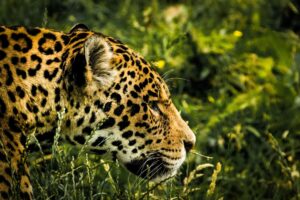Photograph by Brian Skerry
The rich underwater world of Mesoamerican mangroves is mirrored at the surface on Funk Cay, near Gladden Spit in Belize. These schoolmaster snappers and assorted small fry live as hatchlings and juveniles in the protection of the mangroves, venturing out only as adults to the reef.
Photograph by Brian Skerry
A trumpetfish hangs in the coral gardens of Lighthouse Reef atoll off Belize.
Photograph by Brian Skerry
A banded coral shrimp, Stenopus hispidus, works at its station in a tube sponge off Long Cay on Belize’s Lighthouse Reef atoll. With its three sets of claws—one heavy-duty, the other two delicate and surgical—it removes dead tissue, parasites, and fungi from the fish that queue up at the cleaning station.
Photograph by Brian Skerry
Three-foot-long cubera snappers, drawn to Gladden Spit in Belize by a full moon in spring, produce clouds of eggs and sperm in a thunderhead of fertility that rises to envelop divers. Snappers of several species gather here by the thousands, releasing hundreds of billions of eggs.
Photograph by Brian Skerry
A male rainbow parrotfish patrols a bed of turtle grass in Hol Chan Marine Reserve. Scarus guacamaia, the largest herbivorous fish in the Atlantic, uses all three provinces of the Mesoamerican Reef in the course of its life. As a juvenile it seeks the protection of the submerged roots at the fringe of the mangrove forest, from which it makes foraging runs to adjacent sea grass beds. As an adult it makes a home on the reef, with occasional visits to its old haunts.
Photograph by Brian Skerry
Schoolmaster snappers seek the protection of a sea whip in Hol Chan Marine Reserve. In the 1980s Belizean biologist Janet Gibson campaigned successfully for the establishment of Hol Chan, insisting that the marine protected area contain slices of all three crucial Mesoamerican Reef provinces: mangrove, sea grass, and coral reef.
Photograph by Brian Skerry
A whale shark, biggest of fishes, hangs out with small fry off the northern tip of the Yucatán Peninsula.
Photograph by Brian Skerry
A loggerhead turtle grazes. Sea grass is not the typical meal for the primarily carnivorous species, which feeds on jellyfish, crabs, and conchs.
Photograph by Brian Skerry
A view from 12,000 feet, off the coast of Belize, shows the parts of the system that make the whole. The outer reef breaks the force of the ocean swells. Next comes the white line of coral rubble along the reef crest, then the sandy back reef, and, finally, the lagoon: a maze of sand islets, mangrove cays, and sea grass beds.
Photograph by Brian Skerry
A manatee mother with her calf in tow grazes on turtle grass at Swallow Cay in Belize. The West Indian manatee divides its time between sea grass pastures and the waterways of the mangrove forest.
For more information about the barrier reef or Belize, feel free to chat with our Concierge at: concierge@chabilmarvillas.com or contact our Reservations Manager at: reservations@chabilmarvillas.com. Or perhaps you would like to call toll free from the US or Canada: 1-866-417-2377






















